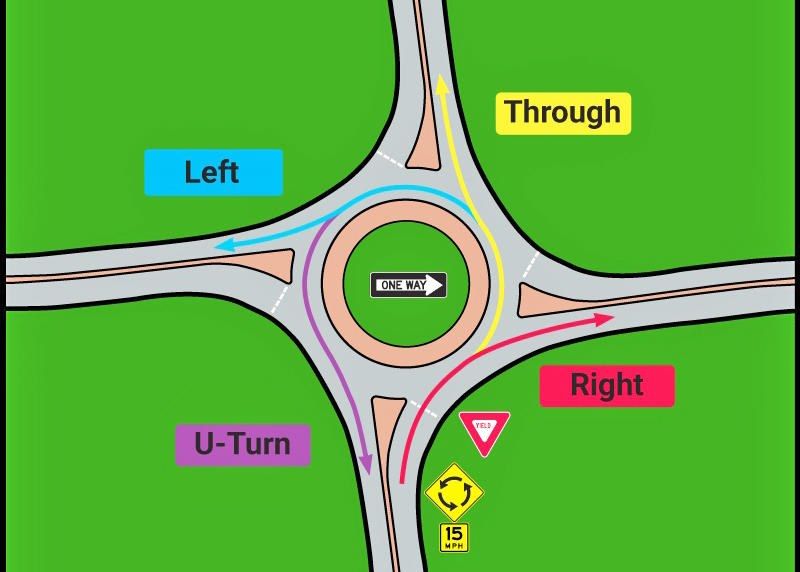Navigating a roundabout not difficult
You’re not alone if you have an aversion to traffic roundabouts. But according to the Ohio Department of Transportation, the dislike of roundabouts originates partially from resistance to change and not understanding how to drive them.
Brock Yoder, permit and traffic safety supervisor for Wayne County, recommends drivers not overthink roundabouts. They are not the confusing maze of roads some people perceive them to be. A roundabout is simply a circle at the intersection of two or more roads. You will enter the circle and then exit where you want.
There are three roundabouts in Wayne County — at Burbank and Smithville-Western roads, on Burbank Road at the entrance to the future Meijer/Menards shopping center, and at Friendsville and Smithville Western roads — with more planned. According to the Ohio Department of Transportation website, roundabouts are becoming more popular as more transportation agencies recognize their benefits. The most common justification for a roundabout is safety.
A roundabout has only eight potential conflict points, versus 32 at a traditional intersection. Studies by the Federal Highway Administration show roundabouts facilitate a 44% reduction in crashes and reduce serious injury and deadly crashes by nearly 90% at two-way stop intersections. When a roundabout replaces a traffic signal, FHWA found a 48% reduction in crashes and a nearly 80% drop in serious injury and deadly crashes. In addition, roundabouts can move traffic more efficiently, which reduces delays and fuel consumption.
Some roundabouts involve multiple lanes, but those in Wayne County are single lane. In U.S. roundabouts, all traffic flows one way, counterclockwise. When approaching a roundabout and while in one, pay attention to the signs (speed limit, yield, directional arrows, et cetera) and the pavement markings.
Slow down when approaching a roundabout. Before entering the roundabout (the circle), look to your left for vehicles already in the roundabout; those vehicles have the right-of-way. Also, look for and yield to cyclists and pedestrians. You may be able to enter the roundabout without stopping, or you may need to slow further or come to a complete stop. When there is an adequate gap in the traffic, enter the roundabout.
Then, once you are in the circle, keep moving until you reach the exit you want to take. You may choose to exit onto the road to the right, the one straight ahead or the one to the left. Or you may drive the entire way around the circle and exit onto the road from which you entered, essentially making a U-turn. According to ODOT and FHWA, turn signals are not required in a single-lane roundabout but are a good idea and a courtesy to other drivers.
All in all, you will be in the roundabout for only several seconds, then safely on your way again if you drive slowly, yield to vehicles and pedestrians, and heed the signs and markings.
Common pavement markings at a roundabout include a row of triangles called dragon’s teeth, which signal drivers to slow down, focus, and watch for cyclists and pedestrians. Thick vertical bars designate pedestrian crossings, and thin horizontal bars may separate the end of a road from the roundabout and indicate drivers must yield there until they can safely merge onto the roundabout.
“The main complaint we hear,” Yoder said, “is that drivers stop and wait at the entrance of a roundabout because they see other cars approaching the roundabout. They need to look to their left, and if no cars are approaching within the roundabout, go ahead and enter.”
Yoder also has heard concerns from people observing semi-trucks driving up over the curbs and assuming the roundabout wasn’t designed large enough. But the Wayne County roundabouts were designed to accommodate semis.
“The curbs are mountable,” Yoder said, “meaning they’re sloped so trucks can drive up over them if necessary.”
The ODOT website says roundabout accidents result when drivers are confused, not paying attention to signs and markings, or drive recklessly. Among the common mistakes made with roundabouts is drivers believing they have the right to immediately enter a roundabout because they’re approaching it. Drivers must yield to vehicles already in the roundabout. This may mean coming to a complete stop before entering.
Entering too fast is another problem. Roundabouts are not race tracks. Take your time in order to avoid collisions with vehicles and pedestrians. Another mistake is stopping or abruptly braking in the circle. Roundabouts are designed so traffic within the circle continuously flows. If you pass by your exit, don’t slam on the brakes to catch it. Simply continue around the circle until you reach it again.
“Anytime changes are made or something new is introduced, there’s a tendency for complaining,” Yoder said. “I would suggest that people try to learn and not get flustered. They will become acclimated to roundabouts.”
The ODOT has posted several videos on YouTube showing how to navigate various types of roundabouts.

